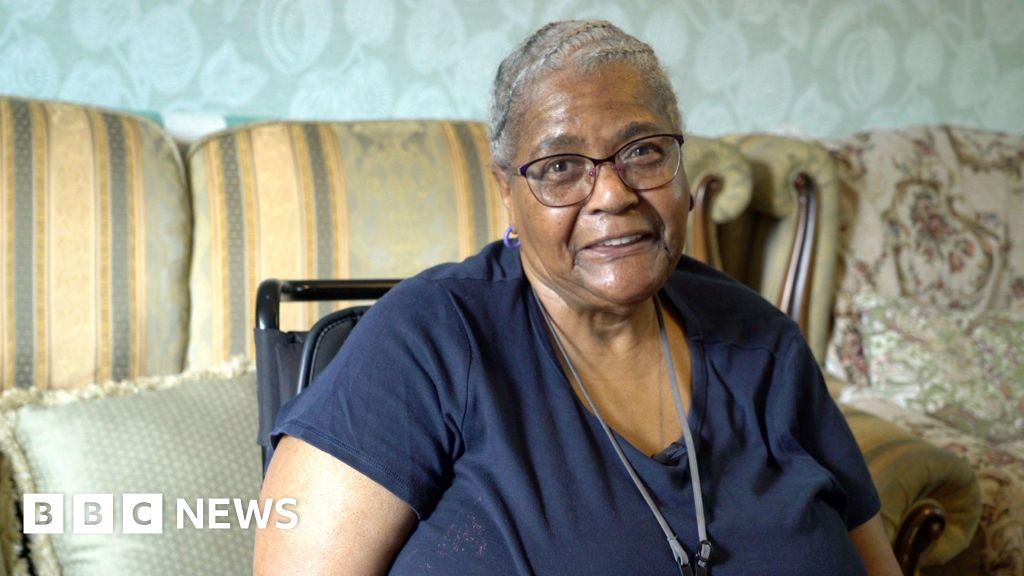Health Correspondent

A woman whose lower leg was amputated after her toes turned black is now looking forward to getting her independence back as she learns “to walk all over again”.
Seven months ago Hazel Howell, from Moss Side in Manchester had the operation to save her life when she developed gangrene in her right foot, the result of type-2 diabetes which had gone out of control.
The 82-year-old, who also has a heart problem told the her initial reaction after the operation was “relief that I was still alive” , but then the harsh reality of losing a limb set in.
“It’s not easy. You have to depend on friends, family. I have to learn to walk all over again”.
Immediately after her operation, Hazel had to learn to walk again using a practice limb, a large inflatable device supported by a frame which cushions the lower part of her own leg in it, before she could safely use a prosthetic leg.
It usually takes three to four months of training and strengthening exercises to safely use a prosthetic leg.
Hazel still has a way to go to fully regain her independence, but she has overcome a huge challenge and is now using a prosthetic.
She said: “When I put the [prosthetic] leg on first, because it hurts, I got a bit downhearted and was a little bit depressed. But somehow, I picked myself up and the encouragement of the family helps me,” she said.
Asked about advice for others going through a similar operation, she added: “Don’t give up hope, keep trying. Because when you give up there’s nothing. But if you keep looking forward there is something ahead and you will meet that thing ahead”.

Modern artificial limbs are often lighter than our own but because they have no muscles or sensation, they can feel much heavier.
Adam El-Fayed, senior physiotherapist, at the Manchester Specialised Ability Centre, said: “People do find it quite challenging, they find the weight of the devices quite heavy.
“It swings like a pendulum, it’s not part of your body, it’s suspended by materials that can move up and down, get caught in the ground, that can twist, rotate.”
Adam said some people ultimately decided that they were more comfortable using a wheelchair.
“50-55% will be issued with a prosthetic leg – roughly a 50% chance at the below the knee amputation level. The higher you go, up to above the knee, it’s less than one in five,” he said.
Prosthetist Shannon Hughes said much of the job is about helping people regain their independence.
She said: “Often people have been through the worst time of their lives and ours is all about trying to get them back to some sort of normality or some sense of being able to achieve things on their own.”
Fitting for a new limb is a multi-stage process, involving numerous measurements, plaster casts, and adjustments to make sure the pressure is on the parts of the remaining leg most able to take the weight.
Patients will need several different casts throughout the first couple of years as the amputation wound heals and the swelling subsides.
Hazel’s leg still hasn’t fully healed since her operation because of her diabetes. She has a genetic predisposition to the condition, which has blighted her family for generations.
Her mum and dad both had the disease, and her brother and son both died of complications relating to it.
Diabetes is a major cause of lower limb amputation in adults. The charity Diabetes UK says it leads to more than 180 amputations a week.
For many people lifestyle plays an important role. Consultant Dr Bhaskar Basu, who is the clinical lead for the service, says the demography of the patients he sees is changing rapidly.
“We used to see diabetes in [patients in their] 70 and 80s, now we’re seeing [them in their] 40s, not only with diabetes but with complications – amputations, diabetic foot ulcers…and blindness.”
The condition can also make it more difficult for those who have had an amputation to learn to use a prosthetic because the remaining leg doesn’t heal properly.
But Adam El-Sayed says people can be surprising.
“In some cases against all odds they’ll come here to the centre to be assessed, and that person might be someone you read on paper as probably not possible for that to happen, then that person defies the odds,” he said
“Ultimately, you can achieve quite remarkable and extraordinary things.”






